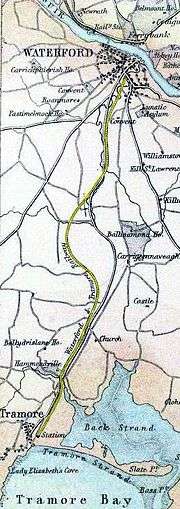Waterford and Tramore Railway

The Waterford and Tramore Railway was an independent line which opened on 5 September 1853, connecting Manor St. in the city of Waterford, Ireland, to the seaside resort of Tramore, 7.25 miles (11.67 km) away. It closed on 31 December 1960.
History
Construction began on 10 February 1853. The Waterford business community financed the 77,000 pounds cost. The William Dargan Construction Company completed the line in 7 months - a considerable achievement as a section of line just outside Waterford ran over deep bogland covered in bulrushes.
In 1925, the line was amalgamated into the Great Southern Railways (GS&WR), which subsequently became part of CIÉ.
The Waterford and Tramore Railway was the only line in Ireland that did not connect to any others. It was one of Waterford's five railways, the others being:
- Waterford, Limerick and Western;
- Waterford and Central Ireland;
- Waterford, Dungarvan and Lismore;
- Dublin and South Eastern.
Closure
On 27 September 1960, CIÉ announced closure of the line and, on 31 December, it was permanently closed, to be replaced by a bus service. To avoid demonstrations, the last scheduled train did not run. The final trains thus were the 1.25 p.m. from Waterford and the 2.10 p.m. from Tramore.
During the first half of 1961, all the tracks were lifted - locally it was rumoured for shipment to Nigeria This, however, was not the case; similar rumours attended many railway closures at the time, but it was scrapped by a Dublin scrap firm. The sleepers were sold for protection against coastal erosion. One of the few remaining traces of the railway is the Station house, which currently serves as the offices of Tramore Failte.
Motive Power
The railway was initially operated by two 2-2-2 tank locomotives supplied by William Fairbairn & Sons in 1855, numbered 1 and 2 plus several other later locomotives. No. 2 was scrapped in 1928. No. 1 continued to operate until 1936 when it was derailed and plunged down an embankment, and cut up on the site. By that stage several other locomotives had been brought in from the main line system to augment what was there. When No. 1 met with its end, It was then the last single locomotive in regular traffic in Great Britain and Ireland.[1] From 1955 the line was operated by diesel railcars.
References
- ↑ Casserley, H.C. (1960). Historic locomotive pocket book. London: Batsford. p. 18.
External links
- History of the line by Ian Flynn and Friends
- Waterford-Tramore Railway: Road Maintenance Costs
- Closure rumours
- Closure debate